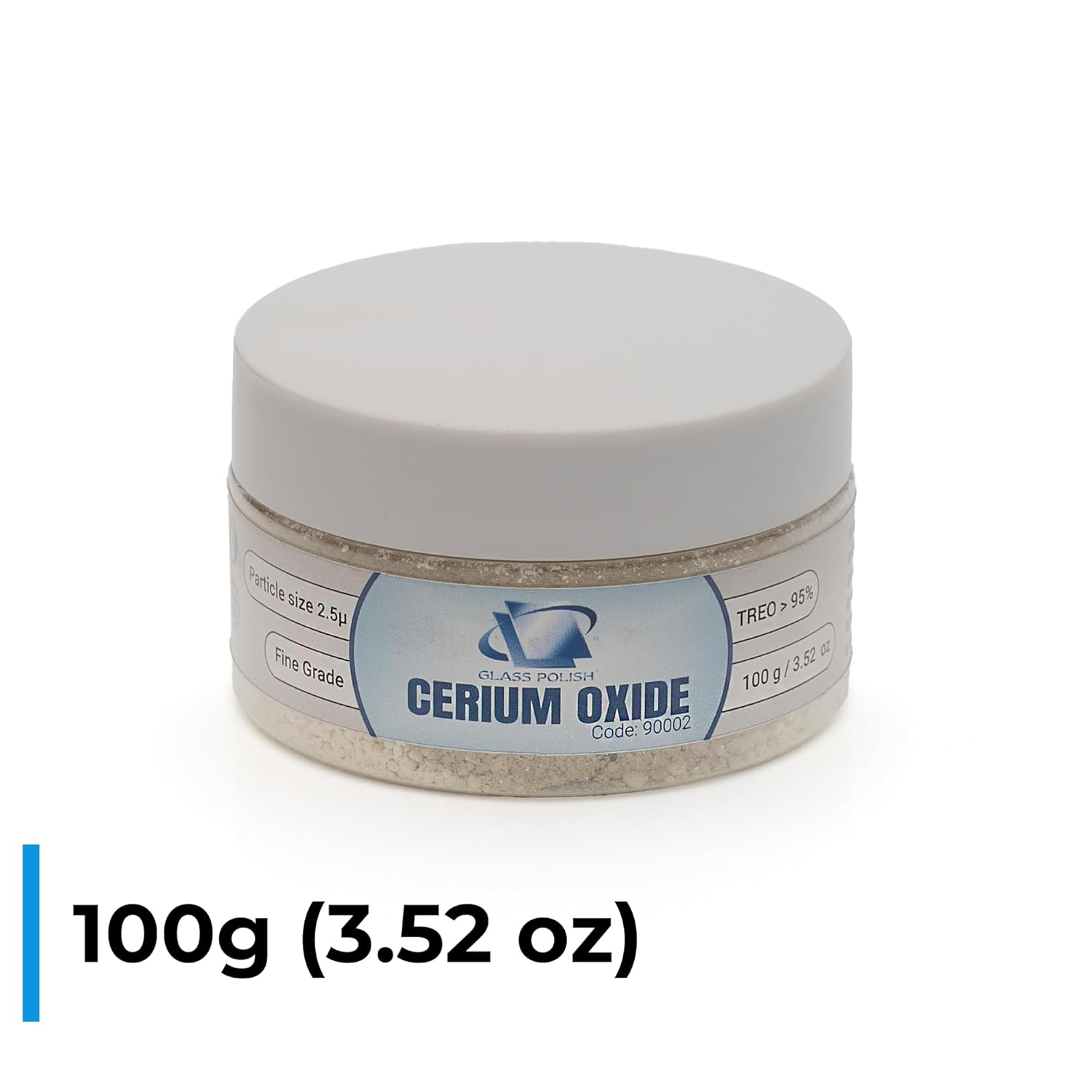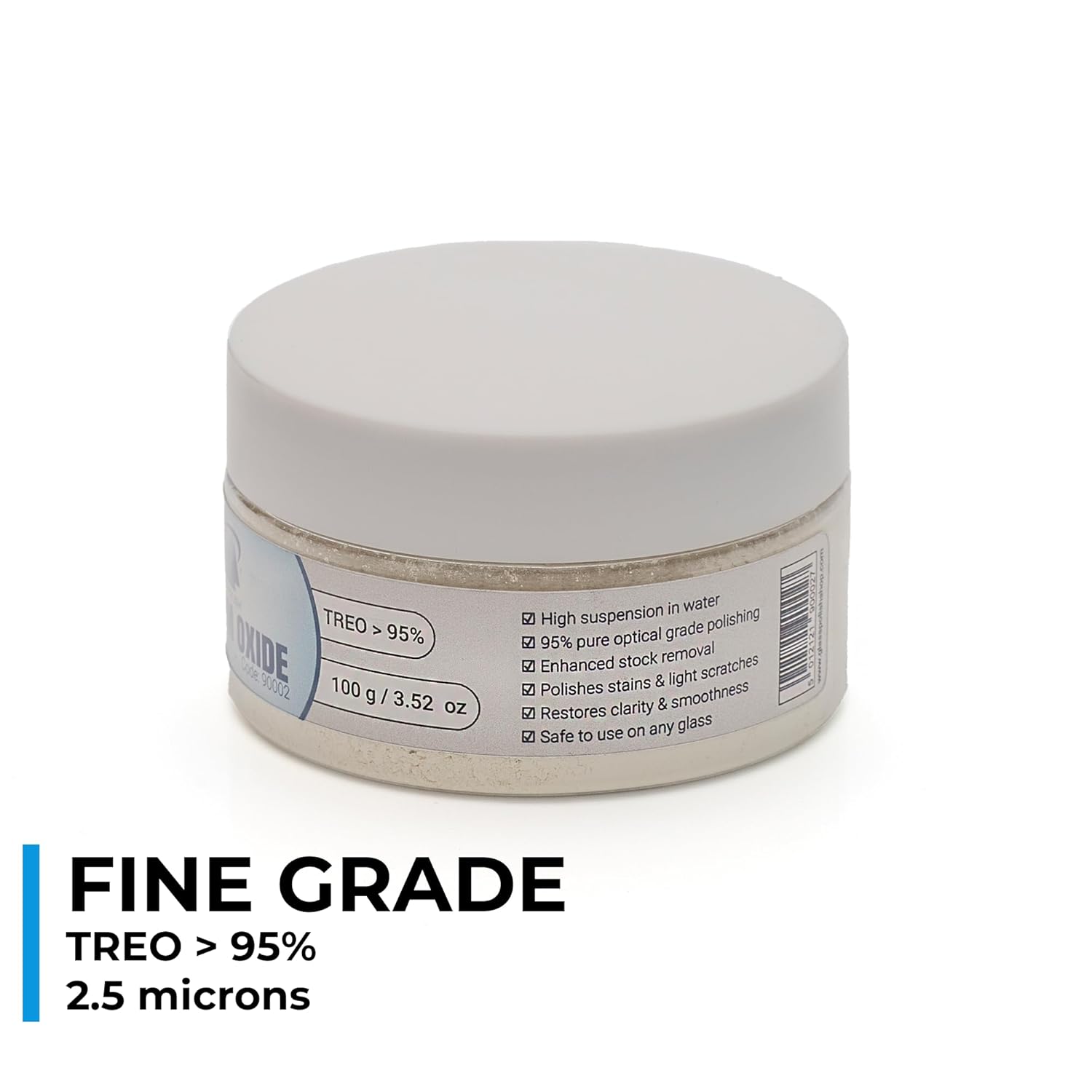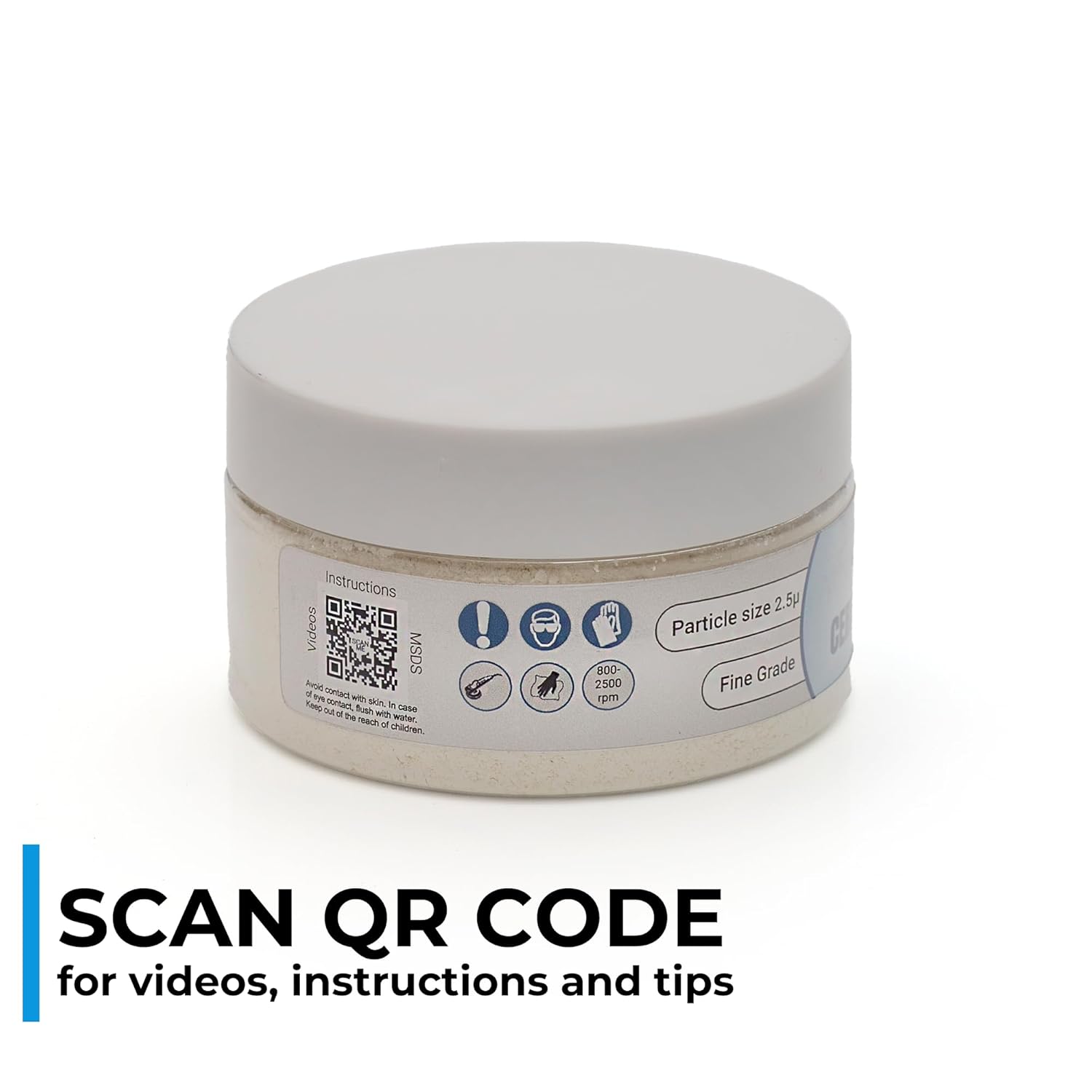Descrição do Produto: GLASS POLISH PRO 3.52oz (100g)
O GLASS POLISH PRO é um pó de polimento de vidro de alta performance, desenvolvido com uma fórmula refinada de óxido de cério, que contém 95% de TREO e partículas de apenas 2,5 micrômetros. Este produto é a escolha ideal para quem busca um acabamento óptico impecável em superfícies delicadas de vidro, como lentes ópticas, lentes de câmeras e cristais de alta qualidade. Com sua capacidade de remover defeitos, o GLASS POLISH PRO elimina imperfeições, marcas de lixamento, arranhões superficiais, opacidade, manchas de água e calcário, resultando em um vidro verdadeiramente cristalino.
É importante destacar que o GLASS POLISH PRO é eficaz apenas para arranhões superficiais, aqueles que mal podem ser sentidos com a unha. Para arranhões mais profundos, recomenda-se o uso de kits de abrasivos ou remoção de arranhões específicos. Este produto é versátil e pode ser utilizado em uma ampla gama de superfícies de vidro, incluindo espelhos, para-brisas, vidro temperado, vidro marinho, telas de chuveiro, fogões de cozinha, mostradores de relógios e smartphones. Além disso, é adequado para pedras preciosas, mármore, cerâmica e superfícies metálicas.
A aplicação do GLASS POLISH PRO é simples e prática. Basta misturá-lo com água até formar uma pasta homogênea e aplicá-lo com um pad de feltro. Para obter os melhores resultados, recomenda-se o uso de uma ferramenta rotativa ajustada entre 1500 e 2000 RPM. O produto é seguro e ecológico, com uma fórmula não tóxica e livre de zinco, sem vapores, tornando-o ideal para todos os ambientes de trabalho, perfeito tanto para iniciantes quanto para profissionais.
Características do Produto:
– Tamanho: 3.52oz (100g)
– Composição: Óxido de cério refinado com 95% de TREO
– Tamanho das Partículas: 2.5 micrômetros
– Solubilidade: Alta solubilidade em água
– Uso: Polimento de superfícies de vidro e outros materiais
– Segurança: Fórmula não tóxica e livre de zinco
– Aplicação: Ideal para uso com ferramentas rotativas a 1500–2000 RPM
– Disponibilidade: Tamanhos variados (1.76 oz, 3.52 oz, 8.8 oz, 1.1 lb, 2.2 lb)
Instruções de Uso:
Para utilizar o GLASS POLISH PRO, inicie misturando uma quantidade adequada do pó com água até obter uma pasta homogênea. Aplique a mistura em uma superfície de vidro utilizando um pad de feltro. Para melhores resultados, utilize uma ferramenta rotativa ajustada entre 1500 e 2000 RPM durante a aplicação. Mantenha a área bem lubrificada durante o processo de polimento e evite aplicar pressão excessiva. Após o polimento, limpe a superfície com um pano macio e seco para revelar o brilho cristalino.
Perguntas Frequentes (FAQ):
Pergunta: O GLASS POLISH PRO pode ser usado em qualquer tipo de vidro?
Resposta: Sim, o GLASS POLISH PRO é eficaz em todos os tipos de vidro, incluindo espelhos, para-brisas, vidro temperado e muito mais.
Pergunta: O produto remove arranhões profundos?
Resposta: Não, o GLASS POLISH PRO é projetado para remover apenas arranhões superficiais. Para arranhões mais profundos, recomendamos o uso de kits específicos de remoção de arranhões.
Pergunta: É seguro usar o GLASS POLISH PRO em ambientes fechados?
Resposta: Sim, a fórmula é não tóxica e livre de vapores, tornando-o seguro para uso em ambientes fechados.
Pergunta: Como posso obter os melhores resultados ao usar o produto?
Resposta: Para melhores resultados, misture o pó com água até formar uma pasta e utilize uma ferramenta rotativa a 1500–2000 RPM durante a aplicação.
Pergunta: O GLASS POLISH PRO é adequado para iniciantes?
Resposta: Sim, o produto é fácil de usar e seguro, sendo ideal tanto para iniciantes quanto para profissionais.
 Frete Grátis em todos os produtos
Frete Grátis em todos os produtos

















Kathy F. –
After a typhoon rolled through my area, my car was left with multiple fine scratches across the windshield from some roofing shingles that hit it. They were right in my line of sight, but rather than replace the windshield, I thought I’d try to buff them out. So I purchased this product and mixed a paste with a little water. It doesn’t take much! I used a Porter-Cable DA buffer and Griots Garage glass polishing pads, also purchased on Amazon. It was my first time using all of these products and the process was very easy. Medium to high speed on the buffer and frequent squirts of water with a spray bottle. Took about a hour of slow and steady buffing, but windshield looks great. No haze or swirl marks from the polish. I can still faintly see the scratches in the sunlight, but I suspect a little more time with the buffer would eventually work the, out. At this point, I’m satisfied. Sure cleaned the glass well too.
S. B. –
With some elbow grease, this works. You will need a foam bit and drill. I had hard water spots on my very old windows and used an abrasive shower cleaner with drill sponge head to scrub the spots off. This was a big mistake on my part and it left scratches all over my window. I taped the window so I could work in sections and as you can see from the pictures, this stuff was able to buff out the scratches in my glass. The section I’ve done so far took about 45 minutes, so be prepared to put in time, but its better than permanently dirty windows or replacing the glass.
Angel –
Es buen pulidor,para limpiar , pulir vidrios de reloj que están rayados
Robert Brown –
It works great, but using it with a drill attachment will fling this stuff all over the place.
The solution is to make a shroud that encloses the drill attachment. Take an empty plastic peanut butter jar (or something similar that is wider than your buffing pad), and drill a hole in the bottom that is a little wider than the shank of the drill attachment. Stick the shank through the hole so that the buffing pad is inside the jar, then carefully cut the jar so that it touches the glass and encloses the pad when you apply normal pressure.
Also, use lots of water and go slow. Pay attention to the temperature because this generates a lot of friction heat and can easily crack the glass if you go too fast.
Robert Brown –
Works for its intended purpose. Cerium oxide will remove minor surface scratches from glass. Must use felt polishing pad with some kind of rotary tool or polisher. Expecting it to remove very deep scratches or chips form glass is unrealistic. Any scratch or chip that deep would require insanely long hours of buffing and result in a large depression and possible dangerous weakening of glass. I used mine on a fish tank. Removed three 2.5 inch long scratches in 45 minutes. Used dremmel with felt polishing wheel. Mixed 1 part cerium oxide with 2 parts water. Don’t allow to dry while using and keep moving to prevent over heating working area. Also it does tend to splatter. Depending on where you are working, may want to use drop cloths. Cleans up fairly easily nonetheless. Didn’t stain cotton tee I got it on and wiped of wall with just water. Google search videos (remove scratches from aquarium glass) for instructional videos on using with glass.
erika gritzmacher –
tut was es soll
Martin –
I’m looking forward for using this product for a scratched tempered glass but I’m also worried it will leave it worse than it is now.
Zak –
I had bad scratches on my windshield from a faulty ice scraper. I used this cerium oxide with a power buffer and the results are amazing. It won’t get rid of deep scratches you can feel with your fingernail tho. It takes a lot of time and work but after many hours I saved myself hundreds by doing it myself. Be prepared for a lot of elbow grease work!! Would Definately use again. Would be great if u could buy already premixed and just shake.
erika gritzmacher –
Pour une utilisation privée
Douglas –
I mixed the slurry as instructed with water > 80 degrees. Used a felt pad for my drill also bought on here. Worked on the scratch for several hours. Absolutely did nothing for scratch except my cooktop now has a cloudy spot at one end of the scratch, but scratch is not affected at all. Waste of money. Felt pad got so hot it started to turn brown. Cooktop got extremely hot as well, but scratch still remained.